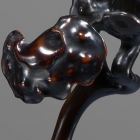J.J. Lally & Co., Oriental Art / New York City, New York
MenuPast Exhibition
ELEGANTLY MADE: Art for the Chinese Literati
March 13-27, 2020
28.
A LACQUERED BOXWOOD RUYI SCEPTER
Qing Dynasty, 18th – 19th Century
carved with a long curving shaft rising to twin longevity fungus (lingzhi) heads and with a small lingzhi head on an arched stem near the middle and a very small lingzhi stem at the end to serve as the loop for a cord or tassel, covered all over with dark purplish-brown lacquer polished to a high gloss.
Length 16 inches (40.7 cm)
Provenance
Kagedo Gallery, Orcas, Washington
Ian and Susan Wilson Collection
Christie’s New York, The Ian and Susan Wilson Collection of Scholar’s Objects, 17 March 2016, lot 1132
Published
Little, Spirit Stones of China: the Ian and Susan Wilson Collection of Chinese Stones, Paintings, and Related Scholars’ Objects, Chicago, 1999, no. 49
Several Qing dynasty ruyi scepters in various materials from the Palace Museum, Beijing are illustrated by Rawski and Rawson (eds.) in China: The Three Emperors, 1662-1795, Royal Academy of Arts, London, 2005, pp. 366-369, nos. 273-282, with captions and further information on pp. 465-466 including a summary history of the ruyi scepter in China by Krahl:
“Ruyi means ‘as-you-wish’ and a ruyi scepter is a talisman presented to bestow good fortune. Its shape and symbolismdeveloped over a long period of time and its auspicious association appears to be connected with Buddhism. Following Indian iconography, in China early Buddhist deities were often depicted holding simple back-scratchers, ... By the Tang period (618-907), these functional items, which often terminated in a small cupped hand, had become ornamental and auspicious. Scepters of the characteristic ruyi shape ... are among the effects of the Japanese Emperor Shōmu (reg. 724-49, died 756) preserved in the Shōsō-in at the Tōdai-ji in Japan. ... A silver scepter of AD 872, donated to a Buddha bone relic in the Famen Temple near Xi’an in Shaanxi province, is already called a ‘ruyi’ in its inscription.
With the temporary decline of Buddhism in the latter half of the Tang, the ruyi scepter’s popularity spread and its shape changed. Being adopted by Daoists, it turned into a longevity fungus (lingzhi), and any shape was suitable for its use as a secular good luck charm. The Yongzheng Emperor revived its auspicious tradition by commissioning examples in various materials and he made the scepter imperial. ... When the Qianlong Emperor officially called upon courtiers to present ruyi scepters upon imperial birthdays and New Year celebrations, their number and opulence increased, and since their only function now was to serve as auspicious objects, free rein was left to the artisans’ imaginations.”
Compare the similar lacquered boxwood ruyi scepter of smaller size in the collection of the Metropolitan Museum of Art, included in various thematic exhibitions from 2004-2011, accession number 1984.382.
清十八 – 十九世紀 黃楊木鏤雕褐漆如意 長 40.7 厘米
來源 華盛頓州 Orcas,Kagedo Gallery
Ian and Susan Wilson 舊藏
紐約佳士得 2016 年 3 月 17 日,拍品第 1132 號
出版 利特爾〈怪石〉芝加哥 1999,49 號
